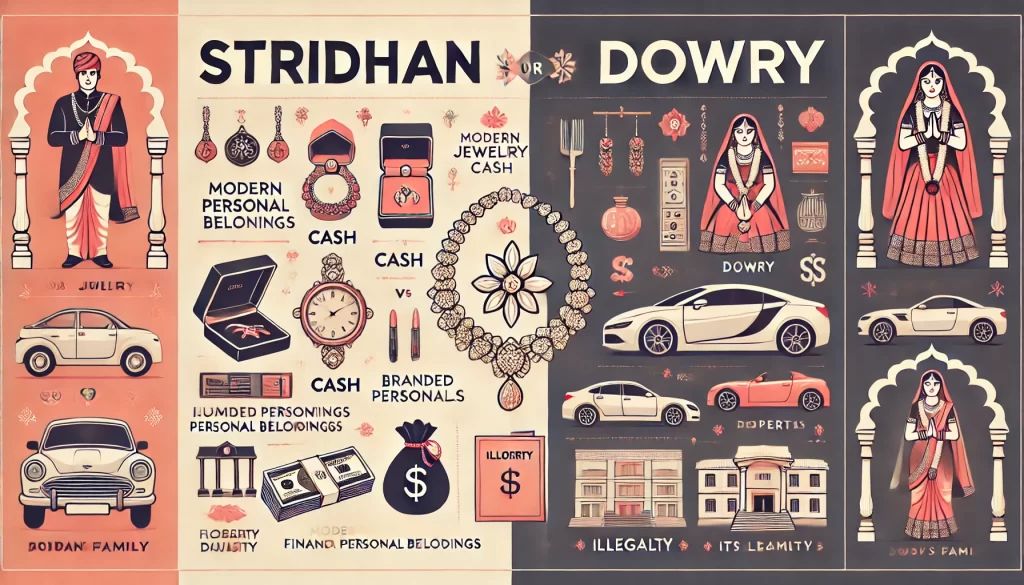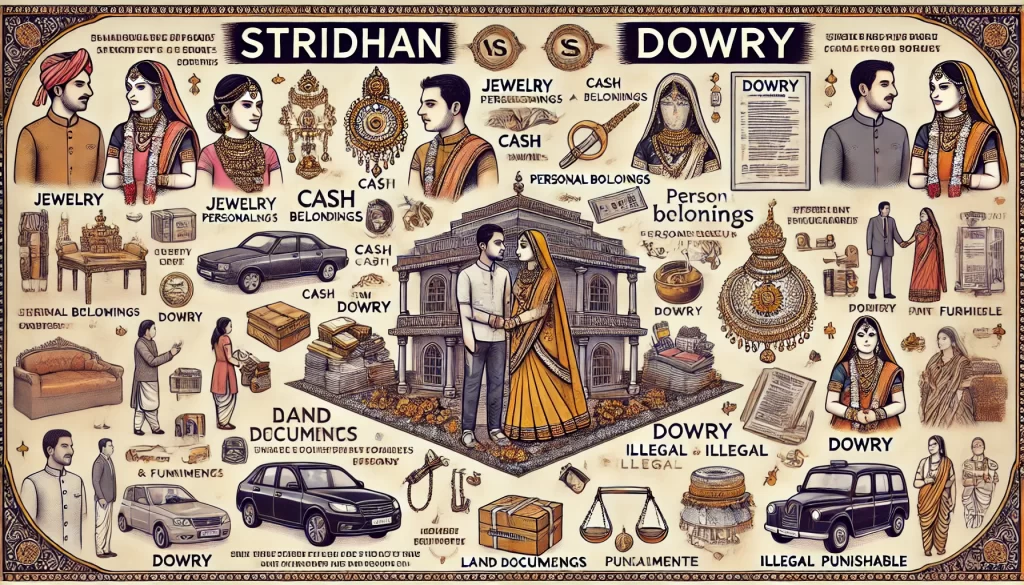Stridhan, a concept with deep roots in Hindu law, represents a fundamental aspect of women’s property rights and autonomy in India. This article delves into the concept of Stridhan, its significance in fostering financial independence and generational wealth, and its associated tax considerations.
What is Stridhan?
Stridhan, or “woman’s property,” includes all assets a woman acquires during her life, especially at marriage, from her family, husband, or in-laws. It encompasses both movable assets, like jewelry and cash, and immovable assets, such as land and real estate. The defining feature of Stridhan is that it grants women complete ownership and control over these assets, allowing them to manage, use, and transfer their property freely, without requiring consent from others.
Stridhan refers to the property that is given to a woman at the time of her marriage or at any other time (like during her lifetime or even after marriage) as gifts by her family, friends, or husband, over which she has absolute control and ownership. The woman has full rights to use, dispose of, or manage it, and it is considered her separate property.
Legal Framework of Stridhan in India
Stridhan’s legal status is primarily defined under the Hindu Succession Act, 1956, which recognizes women’s right to own and manage property independently. Under this act, a woman’s property is classified into two main types:
- Stridhan: Property over which women have full rights of ownership and control. For Example –
- Jewellery gifted by parents at marriage: If a woman receives gold jewellery from her parents during her wedding, this Jewellery becomes her Stridhan. She has full ownership over it, meaning she can use, sell, or gift the Jewellery as she pleases without needing consent from her husband or other family members.
- Cash or property gifted by in-laws: Suppose a woman receives cash or immovable property like a piece of land from her in-laws during the marriage ceremony. This too is classified as Stridhan, giving her absolute rights to manage or dispose of these assets independently.
- Women’s Estate: Property with limited rights, where women do not have complete freedom to dispose of the asset. For Example –
- Inherited property with restricted rights: If a woman inherits property under the traditional law that grants her limited rights to the property (such as the right to enjoy the income from the property but not the right to sell or transfer it during her lifetime), this would be considered a woman’s estate. For example, if she inherits agricultural land from her father, but under the old Hindu law has only a life interest in the property (meaning she can use it but cannot sell it), that is a woman’s estate. Upon her death, the property typically reverts to her legal heirs, usually male relatives, as she does not have full ownership.
- Stridhan gives a woman complete ownership, while woman’s estate refers to property where her rights are limited and typically revert to others after her death.
Stridhan’s Role in Wealth Creation and Financial Independence
Stridhan empowers women by providing financial independence and creating avenues for wealth accumulation. Here are ways it supports wealth creation:
- Financial Independence: Stridhan enables women to own assets independently, fostering self-reliance and reducing dependence on male family members.
- Investment Potential: Women can invest Stridhan assets in business ventures or financial instruments, thereby generating income and growing their wealth.
- Legacy and Inheritance: By passing on Stridhan to daughters or other female relatives, families promote gender equality and enable wealth to be preserved across generations.
Planning for Future Generations with Stridhan
Stridhan not only secures a woman’s financial stability but also benefits future generations:
- Inheritance Rights: Upon a woman’s passing, her Stridhan is transferred to her legal heirs under the Hindu Succession Act. This ensures that wealth remains within the family, benefiting descendants.
- Empowering Future Generations: Passing down Stridhan to daughters and female relatives cultivates financial security and independence from an early age, reinforcing gender equality in asset ownership.
Tax Implications of Stridhan
While Stridhan provides numerous advantages, there are tax aspects to consider when managing these assets:
- Gift Tax: Gifts received as Stridhan may attract gift tax if they exceed specified limits; however, gifts from close relatives are typically exempt under the Income Tax Act.
- Income Tax: Income generated from Stridhan, such as rent from real estate, is taxable and must be reported by the woman as part of her annual income.
- Capital Gains Tax: If a woman sells assets that form part of her Stridhan, such as property or Jewellery, she may incur capital gains tax based on the asset’s appreciation. The tax calculation will depend on the asset’s holding period and nature.

Distinguishing Stridhan from Dowry
It’s essential to understand the distinction between Stridhan and dowry:
- Stridhan refers to assets freely given to a woman, legally recognized as her property. According to Hindu law and Supreme Court judgments, Stridhan is solely the woman’s property, and she can claim it back if she is separated or divorced. The husband or his family has no right over it.
- Dowry involves marriage-related transactions often coerced and is illegal under the Dowry Prohibition Act of 1961. Dowry refers to any valuable property or gifts given by the bride’s family to the groom or his family at the time of marriage. Unlike Stridhan, dowry is illegal in India under the Dowry Prohibition Act, 1961, because it is a social evil often associated with harassment and exploitation of brides.
- Ownership: Stridhan belongs to the woman, while dowry is often given to the groom or his family.
- Legality: Stridhan is legal, while dowry is illegal and punishable by law.
- Purpose: Stridhan is intended for the woman’s welfare and security, while dowry is typically a social pressure or demand placed on the bride’s family.
Judicial Precedents Affirming Stridhan Rights
Courts in India have consistently upheld women’s rights over Stridhan, reinforcing its significance:
- The Punjab and Haryana High Court ruled that any gifts received by a woman during marriage form part of her Stridhan, affirming her legal right to claim these assets if withheld.
- Pratibha Rani v. Suraj Kumar (1985) – In this landmark case, the Supreme Court of India established the foundational principles regarding Stridhan. The court held that all gifts made to a woman before, during, or after marriage are her absolute property. It emphasized that a husband has no right over a woman’s Stridhan, which includes gifts from her family and friends. The ruling clarified that Stridhan is solely owned by the woman, and she has the right to dispose of it as she pleases. This case set a precedent for subsequent rulings on women’s property rights under Hindu law.
- Rashmi Kumar v. Mahesh Kumar Bhada (1997) – The Supreme Court reaffirmed the principles laid out in Pratibha Rani’s case, emphasizing that Stridhan includes all gifts given to a woman at various stages of her life, including before marriage and during the wedding ceremony. The court reiterated that a husband does not have any ownership rights over his wife’s Stridhan and must return it if requested. This decision further solidified the legal standing of women as absolute owners of their Stridhan.
- Mala Kar v. State of Uttarakhand (2024) – In this recent judgment, the Supreme Court reiterated the consistent legal position regarding Stridhan since 1985. The court ruled that a father has no right to claim his daughter’s Stridhan when she is alive and capable of making her own decisions. The case involved a complaint filed by a father seeking the return of his daughter’s marital gifts from her former in-laws, which was quashed by the Supreme Court. The bench highlighted that only the woman has the right to reclaim her Stridhan, underscoring her autonomy in managing her property.
- Mulakala Malleshwara Rao v. State (2023) – In this case, the Supreme Court quashed criminal proceedings initiated by a father against his daughter’s former in-laws for not returning her Stridhan after a divorce. The court ruled that since the daughter was alive and capable of pursuing her claims, her father had no locus standi to file such complaints on her behalf. The ruling reinforced the principle that Stridhan is solely owned by women and emphasized that any legal action regarding it must be initiated by the woman herself.These judicial decisions collectively underscore the unequivocal rights of women over their Stridhan, establishing legal precedents that empower them and promote gender equality in property ownership within Indian law.
Conclusion
Stridhan is a powerful tool for empowering women in India, giving them legal property rights and promoting financial independence. Its impact on wealth creation and generational planning is profound, enabling women to build secure futures for themselves and their descendants. However, understanding tax implications is essential for managing Stridhan effectively. As social norms evolve, Stridhan continues to play a pivotal role in advancing gender equality in property rights, strengthening the economic standing of women within Indian society.


